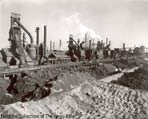
The Automobile and the Environment in American History
Enviromental Cost of the Automobile Production Process
Mass-produced automobiles like most mass-produced commodities entailed the use of a wide variety and vast quantities of resources, the need for great amounts of human labor and mechanical power, and the generation of copious waste products. Some experts conservatively estimated that by about 1980, two million people were involved in making cars and another three million in producing components, with as many as another twenty million throughout the world depending on motorized vehicles for their livelihood. The business concentration of the automobile industry by the 1920s, especially in the wake of Henry Ford’s revolution in mass-production techniques, contributed significantly to the immense scale of production. While there were about 500 small firms in the gasoline-, steam-, and electric-vehicle business in 1910, they produced very few vehicles. The handful of large companies that came to dominate the industry dramatically increased the output. By the 1920s they were producing 98 percent of the world’s cars. Between 1920 and 1929 alone, the production of motor vehicles soared from 2.2 million to 5.3 million. In the 1970s, the automobile industry was the world’s largest manufacturing concern. Estimates for 1990 suggest that there were 630 million motor vehicles on the road around the world, 460 million of which were private passenger cars. Approximately 40 percent of automobiles globally were in North America.
Historian Mark Foster has estimated that “fully one-third of the total environmental damage caused by automobiles occurred before they were sold and driven.” He cited a study that estimated that fabricating one car produced 29 tons of waste and 1,207 million cubic yards of polluted air. Extracting iron ore, bauxite, petroleum, copper, lead, and a variety of other raw materials to process steel, aluminum, plastics, glass, rubber, and other products necessary to construct automobiles consumes limited resources, uses great amounts of energy, and has serious environmental repercussions. In recent years, for example, the automotive industry in several developed countries was a major purchaser of iron and steel (30 percent), lead for batteries (46 percent), aluminum (23 percent), and platinum for exhaust fume control (41 percent). Approximately 75 percent of the cost of the industry’s power comes from electricity, but the auto industry also consumes natural gas (15 percent of energy expenditures), and coal and coke (over 8 percent), as well as steam, oil, and propane.
Vehicle assembly plants themselves are major polluters. In the early 1990s, there were 20 engine plants in the United States, more than 40 assembly plants, hundreds of metal stamping facilities, and thousands of suppliers. Automotive plants release sulfuric acid and other smokestack emissions into the air. In addition, the Environmental Protection Agency (EPA) listed car and truck assembly plants among the top ten waste producers in the country. In 1990, the American automotive industry accounted for 1 percent of all hazardous waste or 172 kg per vehicle produced. Paint shops, in particular, utilize large quantities of solvents; in the State of Michigan, these paint-shop solvents account for almost one-fourth of all pollution from volatile organic compounds. The introduction of water-based paints was meant to drastically reduce solvent contamination, but the retrofitting of paint shops is costly, and the large quantities of water used there and elsewhere in the plants do not leave as clean as when they entered. The network of supply industries, building infrastructure, and transportation systems necessary to produce and deliver vehicles to the consumer also must be factored into any discussion of the environmental impact of the automobile.
It is not clear whether the automotive industry pollutes or has polluted disproportionately to other forms of manufacturing in the United States. And in recent years, automobile manufacturers like other industries have been held accountable for some pollution standards or have attempted to improve some conditions voluntarily. That aside, the scale of the operations are such that one cannot dismiss the role of production in the total picture of the impact of the automobile on the environment.
<<Previous Section - Next Section>>
Introduction
Environmental Cost of the Automobile Production Process
Energy Use and the Internal Combustion Engine
Auto Emissions and Air Pollution
Noise, Visual Pollution, and Derelict Cars
The Automobile's Imprint on the Landscape
Suburbanization and the Automobile
Conclusion
Complete Text Printable View
About the Project | Credits | Contact Us | Student & Teacher Resources | Site Map
©2004-2010 Automobile in American Life and Society

